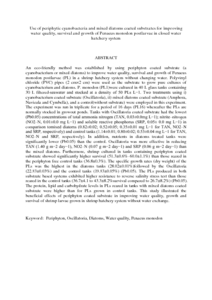Citation
Khatoon, Helena and Md Yusoff, Fatimah and Banerjee, Sanjoy and Mohamed Din, Mohamed Shariff and Mohamed, Suhaila
(2007)
Use of periphytic cyanobacteria and mixed diatoms coated substrates for improving water quality, survival and growth of Penaeus monodon postlarvae in closed water hatchery system.
Aquaculture, 271 (1-4).
pp. 196-205.
ISSN 0044-8486
Abstract
An eco-friendly method was established by using periphyton coated substrate (a cyanobacterium or mixed diatoms) to improve water quality, survival and growth of Penaeus monodon postlarvae (PL) in a shrimp hatchery system without changing water. Polyvinyl chloride (PVC) pipes (2 cm×2 cm) were used as the substrate to grow pure cultures of cyanobacterium and diatoms. P. monodon (PL1)were cultured in 40 L glass tanks containing 30 L filtered-seawater and stocked at a density of 50 PLs L−1. Two treatments using i)
cyanobacterium coated substrate (Oscillatoria), ii) mixed diatoms coated substrate (Amphora, Navicula and Cymbella), and a control(without substrate) were employed in this experiment. The experiment was run in triplicate for a period of 16 days (PL16) whereafter the PLs are normally stocked in growout ponds. Tanks with Oscillatoria coated substrate had the lowest (Pb0.05) concentrations of total
ammonia nitrogen (TAN, 0.03±0.0mg L−1); nitrite–nitrogen (NO2–N, 0.01±0.0 mg L−1) and soluble reactive phosphorus (SRP, 0.05± 0.0 mg L−1) in comparison tomixed diatoms (0.82±0.02; 0.52±0.05; 0.35±0.01 mg L−1 for TAN, NO2–N and SRP, respectively) and control tanks (1.14±0.01; 0.80±0.02; 0.53±0.04 mg L−1 for TAN, NO2–N and SRP, respectively). In addition, nutrients in diatoms treated tanks were significantly lower (Pb0.05) than the control. Oscillatoria was more effective in reducing TAN (1.40 g m−2 day−1),
NO2–N (0.07 g m−2 day−1) and SRP (0.06 g m−2 day−1) than the mixed diatoms. Furthermore, shrimp cultured in tanks containing periphyton coated substrate showed significantly higher survival (51.3±0.6%–60.0±1.1%) than those reared in the periphyton free control tanks (36.8±0.3%). The specific growth rates (dry weight) of the PLs was the highest in the diatoms tanks (28.02±0.01%)followed by the Oscillatoria (22.83±0.03%) and the control tanks (19.83±0.05%) (Pb0.05). The PLs produced in both substrate based systems exhibited higher resistance to reverse salinity stress test than those reared in the control tanks (36.7±4.1 to 43.3±8.2%survival compared to 26.7±8.2%) (Pb0.05). The protein, lipid and carbohydrate levels in PLs reared in tanks with mixed diatoms coated substrate were higher than for PLs grown in control tanks. This study illustrated the beneficial effects of periphyton coated substrate in
improving water quality, growth and survival of shrimp larvae grown in shrimp hatchery system without water exchange.
Download File
![[img]](http://psasir.upm.edu.my/7283/1.hassmallThumbnailVersion/Use%20of%20periphytic%20cyanobacteria%20and%20mixed%20diatoms%20coated%20substrates%20for%20improving%20water%20quality.pdf)  Preview |
|
PDF (Abstract)
Use of periphytic cyanobacteria and mixed diatoms coated substrates for improving water quality.pdf
Download (188kB)
| Preview
|
|
Additional Metadata
Actions (login required)
 |
View Item |

